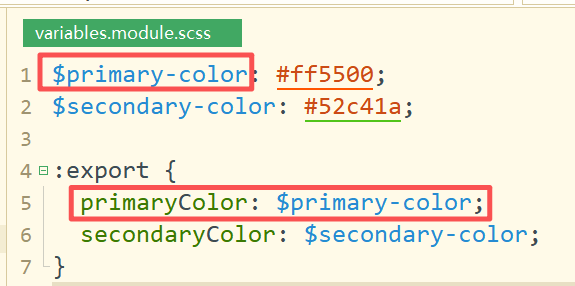最开始的思路是创建scss文件,使用$定义变量,像这样:
css
$primary-color: #ff5500;
$secondary-color: #52c41a;然后在uni.scc文件里全局引入
css
@import "@/styles/variables.scss";在vue文件里使用
css
<style lang="scss" scoped>
.title {
font-size: 36rpx;
color:$primary-color;
}
</style>至此一切顺利,但是!后来我想改变确定对话框里确定按钮的颜色,取primary-color的值。
javascript
<script setup>
const click = ()=> {
uni.showModal({
title:'请查看确认按钮为的颜色',
confirmColor:'#ff5500'
})
}
</script>查阅了很多博客和资料,大多数都是说要创建一个variables.module.scss文件,文件内容如下:
css
$primary-color: #ff5500;
$secondary-color: #52c41a;
:export {
primaryColor: $primary-color;
secondaryColor: $secondary-color;
}然后在vite.config.js(uniapp需要手动创建vite.config.js文件)里配置
css
import { defineConfig } from 'vite'
import vue from '@vitejs/plugin-vue'
// https://vitejs.dev/config/
export default defineConfig({
plugins: [vue()],
css: {
preprocessorOptions: {
scss: {
javascriptEnabled: true,
// 全局注入 SCSS 变量文件
additionalData: `@import "./styles/variables.module.scss";`
}
}
}
})然后在vue文件的style里用$方法获取变量值。
css
<style lang="scss" scoped>
.title {
font-size: 36rpx;
color:$primary-color;
}
</style>如果要在script里使用,就引入import variables from '../../styles/variables.module.scss'
javascript
import variables from '../../styles/variables.module.scss'
const color = variables.primaryColor但是,这样一顿操作后,开始报重复引入的错误,这也不奇怪,毕竟已经在vite.config.js里引入了,然后又在vue页面里引入了一遍。各种尝试后,我决定放弃这个方案。
放弃全局引入,直接在需要变量的vue文件里引入:
javascript
<template>
<view>
<text class="title">{{title}}</text>
<view>{{color}}</view>
<button @click="click">查看颜色</button>
</view>
</template>
<script setup>
import { ref } from 'vue'
import variables from '../../styles/variables.module.scss'
const title = ref('hello uniapp vue3')
const color = variables.primaryColor
const click = ()=> {
uni.showModal({
title:'请查看确认按钮为的颜色',
confirmColor:color
})
}
</script>
<style lang="scss" scoped>
.title {
font-size: 36rpx;
color: v-bind(color);
}
</style>非常完美,是我想要的效果,这个变量值在template、script和style里都能使用。
进一步,我又开始琢磨全局引入的事情,deepseek告诉我,要现在main.js里引入,并且还要配合provide/inject。
javascript
import App from './App'
import variables from './styles/variables.module.scss'
import { createSSRApp } from 'vue'
export function createApp() {
const app = createSSRApp(App)
// 使用provide提供全局变量
app.provide('$variables', variables)
return {
app
}
}vue文件里使用
javascript
<script setup>
import { ref, inject } from 'vue'
const variables = inject('$variables')
const title = ref('hello uniapp vue3')
const color = variables.primaryColor
const click = ()=> {
uni.showModal({
title:'请查看确认按钮为的颜色',
confirmColor:color
})
}
</script>局部引入只需要一句话,而全局引入完全没让步骤变少!所有果断放弃全局引入。
我思考了还有没有进一步优化空间:
variables.module.scss的本质还是将其转换成js变量,供vue文件使用,并且维护变量的时候,scss变量必须手动去export,容易遗漏。

既然最终是要使用js变量,何不直接在js文件里定义变量?
创建variables.js文件:
javascript
const variables = {
primaryColor:'#ff5500',
secondaryColor:'#52c41a'
}
export default variables这样写,变量就方便维护了。
还是在vue文件里局部引入:
javascript
<template>
<view>
<text class="title">{{title}}</text>
<view>{{color}}</view>
<button @click="click">查看颜色</button>
</view>
</template>
<script setup>
import { ref } from 'vue'
import variables from '../../utils/variables'
const title = ref('hello uniapp vue3')
const color = variables.primaryColor
const click = ()=> {
uni.showModal({
title:'请查看确认按钮为的颜色',
confirmColor:color
})
}
</script>
<style lang="scss" scoped>
.title {
font-size: 36rpx;
color: v-bind(color);
}
</style>最后的运行效果:

color: v-bind(variables.primaryColor);这样写会报错,把variables.primaryColor存在color变量里,const color = variables.primaryColor 然后color: v-bind(color);
最后的总结:
在js里使用css变量很难,但是在css里使用js变量就容易多了。